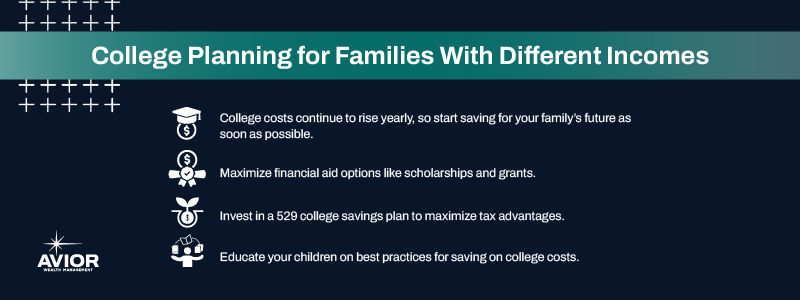College Planning for Families With Different Incomes
No matter your family’s level of income, you have options when it comes to education planning.

The idea of saving for college can be exciting, but higher education is a significant expense that requires smart financial planning for tuition, room, board, books, and overall living costs.
So, where do you start? Your family’s income level and other investment goals will determine the right approach to college planning.
Learn how you identify and implement key strategies for college planning, no matter your financial circumstances.
Breaking Down College Costs
The first step to identifying the right strategies for college planning is to understand the individual expenses that constitute total college attendance costs.
Let’s break them down:
- Tuition and fees: The primary cost of attending college is tuition, which varies depending on whether you attend a community college, private college, or public university. In the 2022–2023 school year, the National Center for Education Statistics reported that the average public institution charged $9,800 per year, with private nonprofit institutions charging an average of $40,700.
- Room and board: Don’t forget about the costs associated with housing and meals, which can be substantial, particularly at out-of-state or private institutions. In many locations, room and board can cost well over $10,000 for the school year.
- Books and supplies: The cost of books and school materials can add up quickly, especially for specialized programs.
- Transportation and personal expenses: Travel, commuting, and day-to-day living expenses can significantly impact your college budget. Factor these into planning.
Once you’ve narrowed down each expense, you can then build a customized savings plan with your financial advisor based on how much time you have left to save and your income level.
Maximizing Financial Aid and Scholarship Opportunities
Resources designed to make higher education more accessible are available to you, such as financial aid programs and school scholarships.
These include:
- FAFSA: The Free Application for Federal Student Aid (FAFSA) is how students get federal grants, work-study programs, and low-interest loans. Completing the FAFSA should be your first step, as it determines eligibility for various financial aid programs.
- Pell and federal grants: Pell Grants are need-based and do not need to be repaid. For the 2024–2025 academic year, the maximum award is $7,395. Other federal grants, like the Federal Supplemental Educational Opportunity Grant (FSEOG), are also available.
- State grants and scholarships: Many states offer aid to residents attending in-state colleges. These can significantly reduce out-of-pocket costs, so check what’s available in your state.
- Institutional aid: Some colleges, particularly private institutions with large endowments, offer substantial need-based aid. For lower-income students, these can cover a big portion of tuition and fees.
- Work-study programs: Federal work-study provides part-time jobs for students with financial needs, allowing them to earn money at their institutions to help pay their education expenses.
- Merit-based scholarships: Many scholarships are based on academic performance, leadership, community service, or other areas of interest or excellence. Even if your family has a low income, pursuing merit scholarships can further reduce costs— sometimes even all tuition costs.
Another tactic you can use to lower your overall college expenses is to start at a local community college, then transfer to a four-year institution. Many states have agreements that make transferring credits straightforward and financially beneficial.
Balancing Your College Savings Options
Middle-income families often find themselves in a tricky position: earning too much to qualify for substantial need-based aid but not enough to comfortably cover out-of-pocket college costs..
Even if you think you don’t qualify for FAFSA or the CSS Profile, you should still complete those applications. It’s common for colleges to offer aid packages that include a mix of need-based and merit-based assistance.
You can also level up your college savings with a 529 savings plan. These are tax-advantaged accounts specifically for education expenses. Contributions grow tax-free, and as long as withdrawals pay for qualified expenses, they’re also tax-free. Starting early with a 529 plan can significantly ease your financial burden when the time to attend college comes around.
Middle-income students should still apply for scholarships and merit-based aid. If savings and scholarships aren’t enough, federal Parent PLUS and private student loans can help bridge the gap. However, keep an eye on the interest rates and repayment terms.
Remember that in-state public universities often offer lower tuition rates for residents. These schools can provide a high-quality education at a fraction of the cost of private or out-of-state schools.
Strategic Planning and Investing
College savings is an essential part of financial planning, but you need the right strategy. Finding that strategy can be challenging regardless of your income level.
Here are a few ways you can maximize educational investments.
1. Leverage Tax Credits
Even if you don’t qualify for need-based aid, you can still take advantage of tax benefits like the American Opportunity Tax Credit (AOTC) or the Lifetime Learning Credit (LLC). These credits can reduce your tax liability based on your education expenses.
2. Use 529 Plans and Other Investment Accounts
High-income families can maximize their savings through 529 plans, but it’s also worth considering other investment vehicles like UGMA/UTMA accounts or Roth IRAs.
These accounts offer different tax advantages and can be part of a more diversified college savings strategy.
3. Invest in Prepaid Tuition Plans
Some states offer prepaid tuition plans, which secure current tuition rates for future use. This can be an excellent option if you’re sure your child will attend an in-state public university.
3. Pay Out-of-Pocket
If you plan to pay for college out-of-pocket, consider strategies that maximize your cash flow, such as paying tuition monthly or using low-interest lines of credit.
This can help you avoid having to liquidate investments during market corrections.
4. Educate Your Family on Finances
Even if finances aren’t a primary concern, it’s still wise to encourage your children to make cost-effective choices, such as attending an in-state school, applying for merit scholarships, or considering a mix of community college and university education.
Find the Right College Savings Strategy With Help From Avior
No matter what income level your family has, the key to successful college planning is starting early, staying informed, and customizing your approach based on your unique goals and circumstances.
There is no one-size-fits-all solution, but understanding your available resources and the right investment strategies will help you succeed.
Work with a financial advisor who can help you improve your education planning and investing strategies. At Avior, our team takes the time to get to know what’s most important to your family, so you can plan with purpose.
Contact Avior today to set up a one-on-one consultation.
Disclaimer: Nothing contained herein should be construed as legal or tax advice. Avior and our Advisors will work with your attorney and/or tax professional to assist with your legal and tax strategies. Please consult your attorney or tax professional with specific legal and/or tax questions. Investment Management and Financial Planner are offered through Avior Wealth Management, LLC, an SEC-registered investment advisor. Past performance is not a guarantee of future results. Investments are subject to loss, including the loss of principal.
No Comments
Sorry, the comment form is closed at this time.




